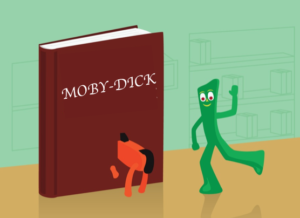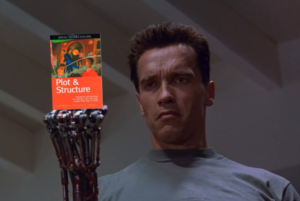by Larry Brooks
Don’t panic, the sanctity of this Killzone space is not about to be compromised. I’ll get to the corset thing in a minute, but first…
I got to hang with KZer James Scott Bell this weekend, at the Writers Digest Novel Writing Conference in Los Angeles, held at the venerable Bonaventure Hotel, where we were both presenting workshops. He was taller than I expected, he said I was taller than he expected, which just goes to show… nothing at all. Except he’s as gracious and cool in person as he is here… that, I did expect.
The lobby at The Boneventure is like walking through a set from Buck Rogers in the 25th Century. No, literally… they shot futuristic scenes for that show right here in the lobby, where I’m writing this post. Thirty years later it still feels ripe for a space station interior or a Hunger Games Capital City mall, but with a concierge and a lobby bar. (For a hoot, click HERE to watch a 25 minute documentary on this topic, including scenes shot here with actors you will recognize from much more recently than Buck Rogers.)
So about today’s title…
Hey, I never said or did that – the corset thing – nor would I. But I would quote it – am doing that now – from an unhappy review for my book, “Story Engineering.” I’m not in the habit of quoting bad reviews, but this one tees up today’s rant, which focuses on a perceived divide out there between writers who value craft, and those who don’t believe in it in favor of simply channeling one’s inner voice and demons and then percolating on it all for what could be years, all leading to a bestselling novel and the perception that this is how it’s done.
For many – newer writers in particular – they believe this because some Famous Literary Author giving a keynote told them so. Maybe that’s where this reviewer heard it:
There is another book about craft, but this is about movies wich (stet) is John Yorke’s “into the woods” (stet). And in page XV (stet) we can find : “You have to liberate people from theory, not give them a corset in which they have to fit their story, their life, their emotions, the way they feel about the world…” Guillermo del Toro. A corset Mr Brooks, yes.
Liberate people from theory. Which is like asking them to figure out the hard things out without any contextual reference points. Just try designing anything with that approach. That’s what this guy is preaching.
Liberate us from the principles that keep us from writing ourselves into a dizzy oblivion of lane changes, proselytization and over-wrought character backstories that hijack the narrative into another dimension while boring reader to tears… theories and principles that help us understand what a novel actually is… yeah, we need to forget all about those kooky fundamentals some of us have learned to value, freeing us to attempt to reinvent a form that has been around for thousands of years.
Those who write this way aren’t reinventing anything. They are simply taking the long road to get there, often backing into once they do, at that.
As a workshop guy, I actually hear this a lot.
I’m guessing that these Famous Literary Author types were fed this line somewhere in their early writing journey. They bought into it, Stephen King perpetuated it (he being one of the few who can actually tell stories this way within a reasonable amount of time) and now stand before us with the rationale that their own bestselling novel (the reason they are behind that podium, which is a legitmate counter-point to all of this) is more the product of their innate genius and a decade of sweating blood – writing and discarding words in 100K chunks while rationalizing this as the dues we must pay – rather than iacknowledging the principle-driven craft of writing (which absolutely does include how stories are structured) that would have perhaps gotten them there in a fraction of the time.
As soon as structure enters the writing conversation, from a podium or otherwise, a lens is applied by some writers, one that doesn’t clarify, but rather, clouds the issue. Because these Famous literary Author keynotes don’t believe there is a structural paradigm that underpins, to some degree (often significant) that renders stories effective. Rather, they believe they made it all up from the thin air of their brain, that they invented whatever it was that made their book great.
Hey, years of pounding on anything, if you have even a shred of literary sensibility – much less genius – will move it toward a form that finally works. And when it does, perhaps leveraging feedback that informed the story’s evolution, it will smack a lot like the very structural, craft-driven principles that they anathematize, which was available from square one for them, as it is for all of us.
Genius, this is not.
I heard one such Famous Literary Author make a quick keynote side comment about craft that went like this: “And sure, we need some craft thrown in, all those semicolons and stuff, we have to get those right.”
Yes indeed. The craft of writing a novel is all about semicolons. Which, if you really think about it, have no business being in a novel in the first place.
At another keynote I heard this spoken with a straight face (his, not mine): “I can’t wait to get to my writing desk in the morning to see what my characters might want to do today.” As if he went to bed the previous night with absolutely no clue. As if the characters are in charge of the story, not him.
They say that, too. And it’s rubbish. It’s hubris, cloaked beneath a false humility, which is what hubris-driven people do.
The book mentioned within this quote-within-a-review and its attribution is from the film world, which is imbued with screenwriting context that suggests certain story beats must appear on a certain page and do a specific thing to the story. Which is by and large true… for them. As a footnote, it is almost always a director who whines about this (as is the case here, rendering the point moot relative to structure in novels), many of which may have a thing for corsets in other contexts, who knows. It is interesting to note, too, that those directors are the ones responsible for changing a script that isn’t working, so I’m not really sure what they’re complaining about… those darn writers who ruin their movies, I guess.
As novelists, especially in deep genre, we have a structural standard that is really more suggestive localization and story management within the narrative than it is a specific target, (other than the midpoint of a story, which is labeled thusly for reasons that are self-explanatory). Novelists have more wiggle room when it comes to how to play into structure, the ability to do just that resulting in precisely what the nay-sayers are holding rallies about: allowing a story to flow in a way that makes sense, rather than jamming it into… well, a corset.
The irony is often lost on Famous Literary Author as he/she tells us how real writers go about their business.
Here are a couple of validities that arise from the calmer middle ground.
An analogy helps put a fence around what the structure conversation for novelists actually is, and is not.
Consider the world of sports. Contests unfold upon fields and courts, each of which has its own set of lines. Boundaries, within which the game is played. If the ball or the puck or the shuttlecock lands outside those lines, if someone steps over one of them at the wrong time, bad things happen. Not a total failure, per se, but a failed moment that becomes a consequence of not looking down.
Those playing fields and courts, those lines, are unassailable parts of the games that are played upon and within them. Nobody questions or ignores them. Nobody feels they can or should move or reinvent those lines, which constitute nothing short of the way the game itself is to be played.
If we are writing genre fiction in particular, the same can be said of the structural expectations that define our game. Readers plop down their money with an expectation of something, include how the story will flow. There hasn’t been a bestselling “experimental” genre novel in decades, but there have been wildly creative ones that play within those genre lines.
And yet – and here is where the corset accusation falls apart like something found in the attic of a century-old second-hand store – nobody at the professional level who is actually playing these games – theirs, or ours – claims to be constrained. Squeezed at the hip, breathless and outraged. Rather, they understand that within those lines, or upon the stage, or within our genre expectations, infinite creativity, flexibility and surprise is abundantly available. That it is, in fact, encouraged and rewarded.
Barishnikov never felt constrained because he could not dance his way off the stage and into the box seats for a foot rub. At least at the Bolshoi, he couldn’t. Roger Federer isn’t posting rants about the fact that he can’t win a point if his serve lands beyond the service line.
So who is doing this bitching and moaning, anyhow?
Too many writers have been taught that they must suffer greatly… precisely because they believe there are no boundaries or principles that guide them. And yet, such a belief becomes the main constraint on their writing. They are like teenagers turned loose in New York city with no map and no phone, with money to spend and a finite window in which to play. What to do? Well first, get lost…
This belief system is why novels from Famous Literary Authors often take years to get right. But as it is in life, if you have no principles, if you believe in nothing other than your own brilliance and unrestrained will and the freedom to make up your own rules, you have infinite ways to screw it all up.
The conversation is muddied even more by the fact that often those authors (who may have indeed recently sold millions of copies of that ten-years-in-the-making literary behemoth) can’t actually explain how they got to where they ended up. Or why it works. (The last such keynoter explained his success because his novel was narrated by a dog… literally, a dog reincarnated as a human, but with his superior dog’s world view. That’s a genius concept, by the way… and it is precisely what explains the novel’s market appeal, rather than some deeper meaning to mankind that took the writer years to understand
The irony is palpable. After all that suffering and swimming against the current of craft, after all that feedback and revision and catharsis, the draft that worked for them actually did align with the very principles of craft that were available to them at the idea stage. What to do with an idea isn’t cosmically mysterious, it’s driven by craft if you let craft guide you. One’s knowledge of craft is the means of vetting an idea in the first place.
Listen closely, and you’ll realize those keynoting literary authors are talking about process, not product. For them it’s all just one big amorphous, vapourous precipitation of ethereal pondering called writing, and for them it takes years to summon forth.
Find your truth, the keynote speaker tells us with ominous gravitas.
Dude, I write violent psycho-sexual thrillers (some with corsets involved) in which guys like you get thrown off trains to scare the locals. Tell me what being true even means in that context.
It’s lit-speak. Rhetoric. The narrative of not really knowing, but faking it until you do. If you are treading water you are not yet drowning. Meanwhile, some writer floats by in a raft called craft, tries to throw you a line, and you wave it off.
Listen to such preachings. And then hear it for what it is. Writing advice, from any source is like that old adage about fortune cookes, where you add “in bed” to the end. When someone tells you what process you should use, which process is best, add “for him/her” to the end of it.
The best process, in any genre, is one that is informed by the principles of quality storytelling.
And when someone credible talks you about craft… listen hard and then take notes. Listen and read as much as you can, and then notice how all the real craft guys are saying the same things, almost exactly by intention if not the same vocabulary applied… because that is how stories are built, no matter how you get there.
You’re in the right place here on Killzone. Oh, we love our characters, too, just as much, in fact, as Famous Literary Author. But armed with craft – including structure – we know what to do with them – we actually give them something interesting to do in a story – how to propel them down a dramatic path that asks readers to root for them, rather than just observe them outgrowing a crappy childhood.
As for me and Jim Bell and the other contributors here on Killzone, that’s us outside the conference cocktail party, hitting balls back and forth on the court that defines our game, hoping we can land a few between the lines.
*****
Permission to pitch? It’ll be quick, I promise.
I am on the cusp of launching a new craft-driven venture, wherein I produce and market video-based training modules leveraging the clarity of the Powerpoint experience and the narrative intensity of being spoken to in a visual context. Just like in a live workshop. I’m calling it The Storyfix Virtual Classroom, and there will be many modules online very soon.
I’m inviting you to opt-in to my mailing list for this, to be among the first to learn about new programs just as they are released, and to receive perpetual discounts and other bonuses – training and otherwise – that aren’t available to non-list writers. As a further incentive, you’ll receive the first training module out of the gate: Essential Craft for Emerging Novelists, which will be designed to lop years off your learning curve with one hour of focused training.
It’s hardcore craft training for serious authors. I hope you’ll join me.
Click HERE to opt-in this mailing list, which will trigger an email asking you to confirm (through Mailchimp). It’s free, of course, and there is always an opt-out available. And I promise I won’t bomb your inbox with unrelated stuff.
Also, by clicking that link you’ll be able to see the new trailer I’ve produced for the program, which I hope you’ll agree is pretty cool. Your feedback is always welcome… this program is for you, help me make it better by telling me what, specifically, you’d like to see covered in these trainings.










